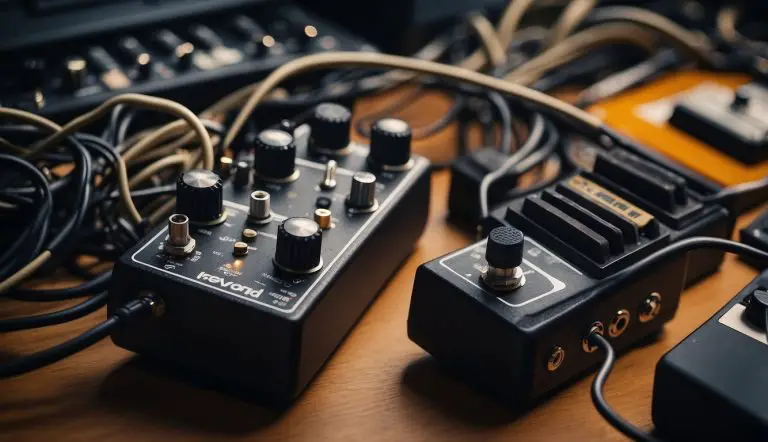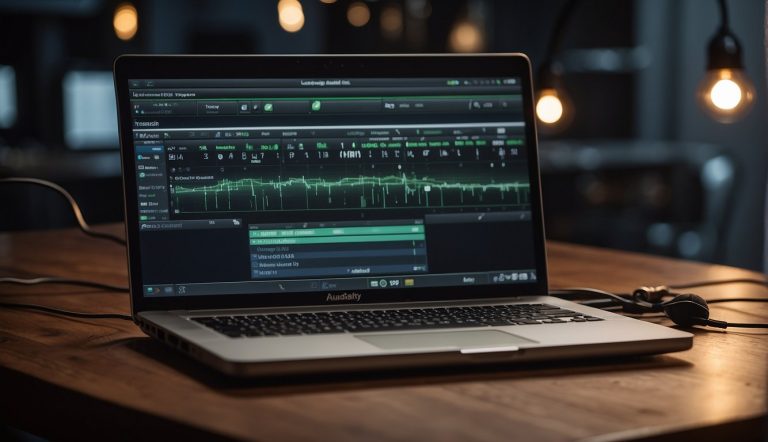What Does a Compression Pedal Do?: Unveiling Its Role in Music Production
A compression pedal is an essential tool in a guitarist’s arsenal, serving to even out the dynamic range of the audio signal.
When I play notes on a guitar, the volume can vary significantly, with some notes naturally sounding louder or softer than others.
By using a compressor pedal, I can control these dynamics, ensuring a more uniform and polished sound.
The pedal operates by reducing the volume of louder signals while boosting quieter ones, according to a set threshold and ratio.
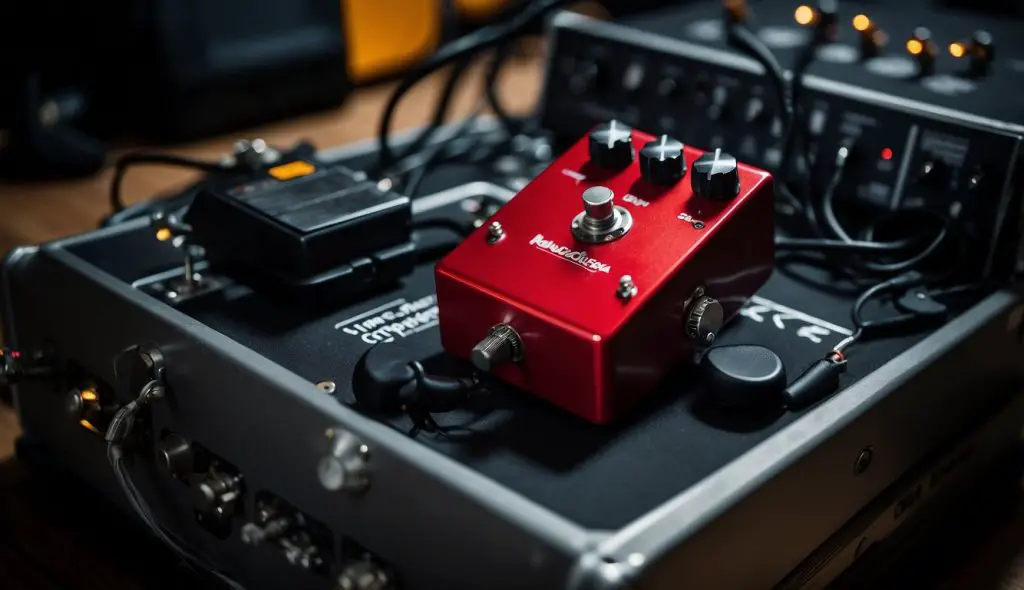
Compressor pedals come equipped with various controls that allow for precise manipulation of the sound. The main components typically include knobs for adjusting the level, threshold, attack, release, and sometimes a ratio or knee control.
These parameters enable me to shape the envelope of the guitar tone, tailoring the compression effects to fit the style of music I am playing.
The nature of these controls also allows for creative applications beyond mere volume management, such as enhancing sustain or adding punch to my playing.
Key Takeaways
- A compression pedal normalizes the dynamic range of guitar sounds.
- It includes controls like level, threshold, attack, and release for sound shaping.
- Compressor pedals are versatile, useful for tone enhancement and sustain.
Table of Contents
Why Use Compression?
In my experience with music production, compression is essential for managing the dynamics of a guitar signal, ensuring that the sound is even and polished.
Purpose of a Compressor Pedal
A compressor pedal is fundamental when I need to control the dynamic range of my guitar’s sound. Dynamics refer to the variance in loudness between the softest and loudest parts of my performance.
By adjusting these dynamics, the compressor pedal helps me maintain a more consistent sound level, which is particularly beneficial during live performances and recording sessions.
- Even Out Sound: It reduces the volume of louder notes while boosting quieter ones.
- Prevent Clipping: By controlling dynamic spikes, it helps avoid unwanted distortion.
Basics of Dynamics and Sustain
Understanding the basics of dynamics and sustain is crucial when I manipulate my guitar’s signal. The compressor serves two primary functions:
- Dynamic Control: It acts like an automatic volume knob that turns down louder signals and turns up softer ones, keeping my guitar’s output within a specific volume range.
- Sustain: By raising the level of the tail of my notes, the compressor provides a longer sustain, allowing notes to ring out more fully without a rapid decay.
- Enhanced Sustain: Without altering my playing, notes sustain longer, giving me a smoother sound.
- Balanced Performance: It helps in achieving a balanced performance by mitigating dynamic disparities.
The Key Components and Controls of Compressor Pedals
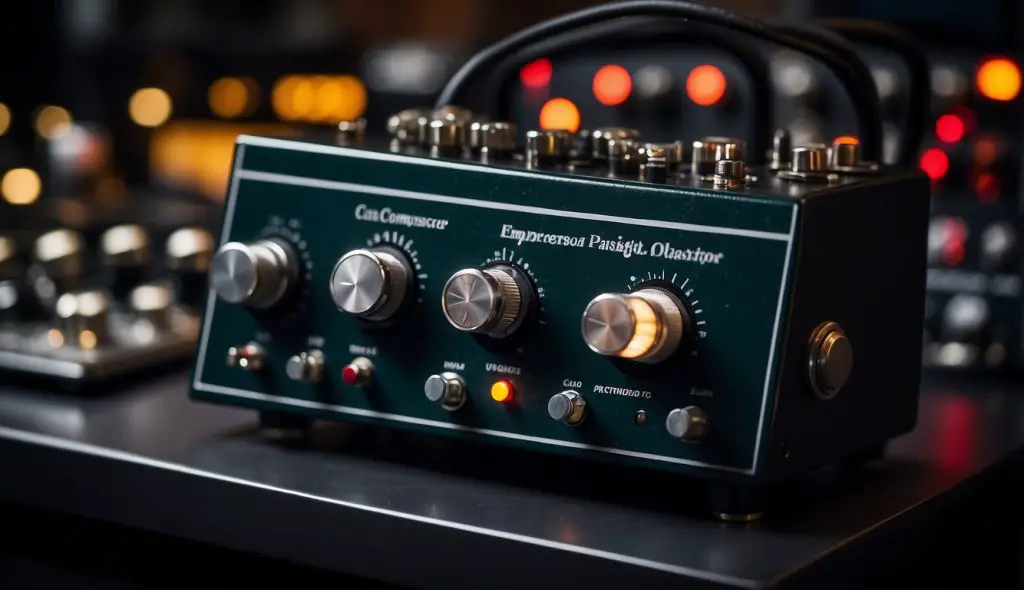
In my experience with compressor pedals, mastering their controls is fundamental to shaping the dynamic response of an electric guitar. Here, I’ll dissect the main components and adjustments that are crucial for the operation of these devices.
Threshold and Ratio
Threshold is where compression begins. When the signal level exceeds this point, the pedal starts to apply gain reduction.
Typically, the ratio determines the intensity of this compression—for every decibel over the threshold, the signal is reduced by the ratio amount. For example, a 4:1 ratio reduces excess signal by one fourth.
Attack and Release Time
The attack time dictates how quickly the compressor reacts to signals that cross the threshold. A fast attack squashes the transient immediately, whereas a slower attack allows some initial punch through.
Release time sets how quickly the compression effect stops after the signal falls below the threshold. A quicker release will make the instrument sound more natural, while a longer release can sustain notes.
Level and Makeup Gain
After compression, the pedal’s level or makeup gain control allows me to compensate for any overall volume reduction caused by gain reduction. It’s crucial for maintaining output consistency.
Knee and Tone Control
The knee setting adjusts how the compressor transitions from no compression to full compression—soft knee for a gradual transition, and hard knee for a more abrupt one.
Some pedals offer a tone control to tweak the sound’s character, balancing warmth and clarity affected by the compression.
Different Types of Compressor Pedals
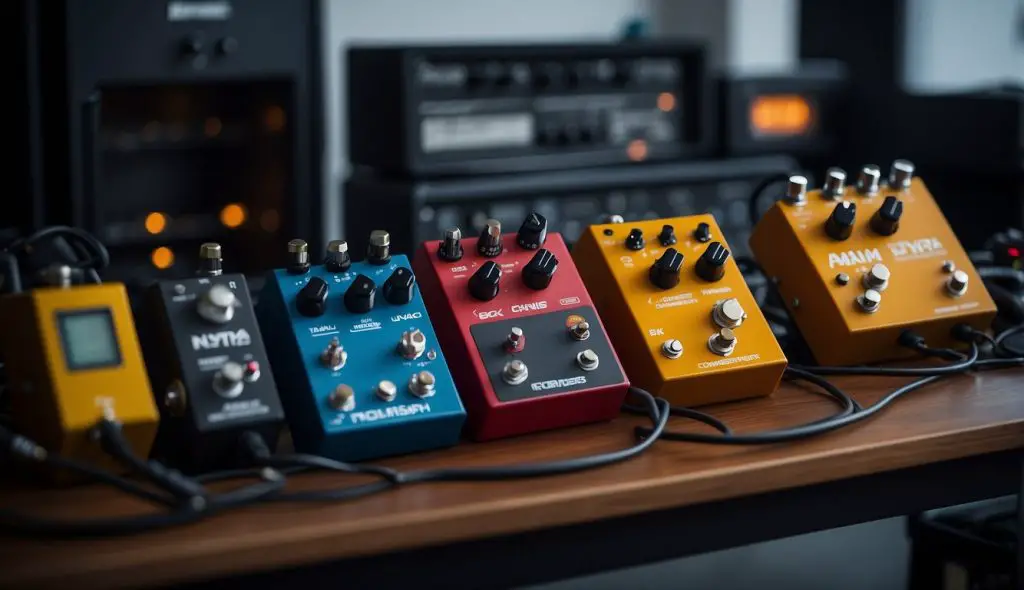
In my experience with compressor pedals, I’ve found that they are essential tools for musicians who want to manage the dynamics of their sound. Each type of compressor pedal uses different technologies to achieve this effect:
VCA Compressors
VCA stands for Voltage Controlled Amplifier, and these compressors are prized for their precision and clarity. They use an integrated circuit to control the gain level, hence adjusting the volume of the signal smoothly.
Their response times are usually quick, making them ideal for sharp dynamic control.
Optical Compressors
Optical compressors are known for their smooth and natural compression. They employ a light element and an optical cell; as the signal gets louder, the light gets brighter, which in turn reduces the signal level.
This mechanism gives a subtle and musical compression effect which is why I find them to be particularly useful for studio recording.
FET Compressors
FET, or Field Effect Transistor, compressor pedals replicate the aggressive and snappy quality of classic tube circuits. They use transistors to emulate a warm, vintage sound, adding character and punch to the signal. This makes them a favorite among guitarists and bassists looking for an analog feel.
Applications – Where and How To Use Compressors
A compressor pedal is crucial for shaping the dynamics of my guitar’s sound. I utilize this device to even out my playing levels and enhance sustain, which helps maintain a consistent tone regardless of my playing style.
Compressor Settings for Various Playing Styles
When I’m playing electric guitar with a heavy picking style, I set my compressor with a higher ratio and a threshold to manage peaks and to add punch.
For a subtler sound like fingerstyle on an acoustic guitar, I adjust the compressor to have a lower ratio which provides a gentle smoothing of the dynamics.
In each case, the attack and release settings are also crucial; I set a fast attack to quickly manage transients for fast passages and a slower attack for a more natural sound.
- Heavy Picking (Electric): High ratio, lower threshold, faster attack.
- Fingerstyle (Acoustic): Lower ratio, moderate threshold, moderate attack.
Using Compression in a Mix
In a mix, compressors serve to control dynamics and ensure my guitar parts don’t overpower other instruments.
I use subtle compression settings on the bass guitar to maintain a solid foundation without causing it to stand out unnecessarily. For solos on the electric guitar, I might increase the ratio and make use of a lower threshold to bring the guitar forward in the mix.
- Bass Guitar: Low ratio, auto release, enhance consistency.
- Lead Electric Guitar: Higher ratio, lower threshold, accentuate presence.
Integration with Other Effects Pedals
I carefully consider the order of my effects pedals to shape my overall sound. Typically, I place the compressor pedal early in the signal chain, right after my tuner.
This helps to even out the dynamics before the signal runs into overdrive or delay pedals, which can magnify any volume inconsistencies.
- Signal Chain Example: Tuner -> Compressor -> Overdrive -> Modulation -> Delay/Reverb
By strategically using my compressor pedal and adjusting its settings, I can adapt to any playing style, ensure my guitar sits well in a mix, and integrate it effectively with my other effects pedals to create a cohesive and expressive tone.
Advanced Techniques
In this section, I will discuss how a compression pedal can enhance your sound quality and dynamic control. I’ll focus on its role in achieving a professional sound and how it can be an essential tool for live performances.
Achieving a Professional Sound
My recordings benefit greatly from a compression pedal when I aim for a polished, studio-quality sound. Employing compression allows me to even out the dynamic range, ensuring that the loud parts do not overpower the soft parts.
This creates a balance that is both pleasant to listen to and professionally consistent. Specifically, I make use of the pedal to:
- Smooth out the audio signal: By reducing the volume of peaks and amplifying the quieter sections, the overall sound becomes more cohesive.
- Enhance sustain: Especially for stringed instruments, the pedal can prolong the natural decay of the note, offering a richer sound.
Controlling Dynamics in Live Performances
In a live setting, my compression pedal is invaluable for managing the dynamics of the performance. It allows me to maintain a consistent level of sound which is critical in the often unpredictable live environment. Here’s how I approach controlling dynamics:
- Prevent audio clipping: During energetic parts of the performance, the pedal helps prevent the sound from peaking too high and causing distortion.
- Provide a steady output level: Regardless of whether I play aggressively or softly, the compression pedal ensures that my audience experiences a steady volume, contributing significantly to a professional live sound experience.
Frequently Asked Questions
In this section, I will cover some of the most common inquiries about compressor pedals, detailing their benefits and uses for both live performances and studio recordings.
How can a compressor pedal improve guitar tone?
Using a compressor pedal helps to even out the guitar’s dynamic range by boosting quieter sounds and attenuating louder ones. This results in a more balanced tone that can enhance sustain and add punch to the guitar’s output.
What are the optimal settings for a compressor pedal?
The optimal settings for a compression pedal depend on your playing style and the desired effect. Typically, a lower ratio with a moderate attack and release time can provide a natural sound, while higher settings can create a more pronounced and controlled tone.
Why might a bass player want to use a compression pedal?
A bass player may use a compression pedal to maintain a consistent level of output, which is especially useful during live performances. It helps prevent peaks that may cause distortion and ensures that the bass sits well in the mix.
When is the ideal time to incorporate a compressor pedal in my playing?
I suggest incorporating a compressor pedal when you need to control the dynamics of your playing or want to add sustain without increasing distortion. It’s also useful for creating a tighter sound with rhythm parts and during solos for a more polished tone.
Can a compressor pedal help reduce unwanted noise?
Yes, a compressor pedal can help reduce unwanted noise by using a noise gate feature or by attenuating spikes in your signal that might cause feedback or noise. However, it may also raise the noise floor if used excessively, so it’s important to find a balance.
What’s the difference between optical and other types of compressor pedals?
Optical compressor pedals rely on a light-dependent resistor and an internal light source to adjust gain reduction, offering a smoother and more musical compression. Other types, like VCA or FET compressors, may respond quicker and provide a more aggressive form of compression, suitable for percussive playing styles.



